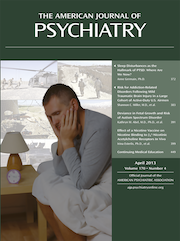Response to Ritvo and Ritvo Letter
To the Editor: The goal of our article (1) was to examine the impact of the new DSM-5 criteria for autism spectrum disorder (ASD) in three large samples of children with DSM-IV-defined ASD and non-ASD disorders. Using items from the Autism Diagnostic Interview–Revised and the Autism Diagnostic Observation Schedule to match DSM-5 criteria, we found that the new criteria correctly classified a large majority of children with ASD (91%), including very young children, girls, and children without language impairments. We also found that the specificity of the new criteria represented an improvement over existing DSM-IV criteria.
Ritvo and Ritvo’s commentary about our article and about the upcoming changes to DSM criteria center on two main concerns: 1) that the changes introduced by DSM-5 will affect the sensitivity of the diagnostic criteria and 2) that the changes to DSM-5 criteria will limit the usefulness of ASD data banks.
The possibility of decreased sensitivity in diagnostic criteria is a valid concern. In fact, the initial motivation for our study was to examine whether children with previous DSM-IV diagnoses of any pervasive developmental disorder (PDD) would be incorrectly left out by the new criteria. As Ritvo and Ritvo note, when based on parent-reported symptoms only, approximately 9%−10% of our sample meeting DSM-IV criteria for ASD was not correctly classified by DSM-5 criteria. However, it is important to reiterate that the sensitivity of identification was much more likely affected by the methods of the study—using diagnostic instruments not designed to address the specific revisions in DSM-5—than by the DSM-5 criteria. Our results show that relying on clinical observation in addition to parental report of symptoms improved the sensitivity of the proposed DSM-5 criteria, and in many cases this resulted in sensitivities similar to those for DSM-IV criteria (see Table 2 in our article [1]).
Ritvo and Ritvo expressed particular concern about the sensitivity of the new criteria for Asperger’s disorder because of the relatively small proportion of our sample for whom this DSM-IV diagnosis was used. However, we reiterate that separate analyses were performed with 261 case subjects with Asperger’s disorder and 971 case subjects with PDD not otherwise specified (PDD-NOS), and similar results were obtained when both parental report and clinical observation were used. As for previous studies that reported DSM-5 criteria to have poor sensitivity, we refer the reader to Swedo and colleagues’ commentary (2) for a full discussion on the limitations of those studies. To assess the true sensitivity of the new criteria, field trials are necessary.
A second and important issue raised by Ritvo and Ritvo involves the effect of the new criteria on the utility of previously collected phenotypic and genetic ASD samples. They speculate that the changes in diagnostic criteria will make these samples “incompatible and unusable.” The authors assume that some of the existing cases will lose their ASD classification. However, our study results indicate that this is unlikely to be true. The new DSM-5 criteria now explicitly state that individuals with a well-informed clinical diagnosis of any of the previous PDD subtypes, including PDD-NOS and Asperger's disorder, do not have to be rediagnosed but are assumed to fall under the new larger category of ASD. Importantly, the revisions in DSM-5 provide researchers and clinicians an alternative system for coding dimensions both within ASD and from other areas, including intellectual disabilities, language disorders, and other disorders such as attention deficit hyperactivity disorder, through clinical specifiers. This system should result in more accurate and meaningful descriptions of individuals (see Grzadzinski et al. [3]).
In closing, we remind the reader that the upcoming changes to the DSM criteria reflect the growing body of empirical work showing that the existing classification system needs improvement. Comparisons of DSM-IV subtypes do not reveal consistent differences in clinical presentation (4), and longitudinal studies indicate that these categorical distinctions are not predictive of outcome (5). More recently, research has demonstrated that DSM-IV categorical diagnoses are not reliably made across clinical and research sites (6). With our current classification system, what diagnosis you get (e.g., ASD or Asperger’s disorder) is more related to where you go for the diagnosis than to the pattern of presenting symptoms. Thus, while we respect the concerns outlined by Ritvo and Ritvo, the evidence indicates that it is neither scientifically nor clinically justifiable to continue using DSM-IV criteria in the face of data indicating its significant limitations in describing individuals with ASD.
1 : Application of DSM-5 criteria for autism spectrum disorder to three samples of children with DSM-IV diagnoses of pervasive developmental disorders. Am J Psychiatry 2012; 169:1056–1064Link, Google Scholar
2 : Commentary from the DSM-5 Workgroup on Neurodevelopmental Disorders. J Am Acad Child Adolesc Psychiatry 2012; 51:347–349Crossref, Medline, Google Scholar
3 : DSM-5 and autism spectrum disorders: an opportunity for identifying ASD subtypes. Mol Autism (in press)Google Scholar
4 : Annotation: the similarities and differences between autistic disorder and Asperger’s disorder: a review of the empirical evidence. J Child Psychol Psychiatry 2004; 45:421–434Crossref, Medline, Google Scholar
5 : Similar developmental trajectories in autism and Asperger syndrome: from early childhood to adolescence. J Child Psychol Psychiatry 2009; 50:1459–1467Crossref, Medline, Google Scholar
6 : A multisite study of the clinical diagnosis of different autism spectrum disorders. Arch Gen Psychiatry 2012; 69:306–313Crossref, Medline, Google Scholar



